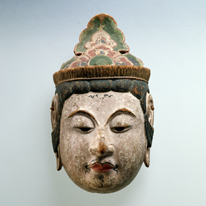Past Exhibitions
- Feature Exhibition: Japanese Masks: From Religious Procession to Noh Performance
- June 9, 2015 - July 20, 2015
This exhibition features approximately thirty heirloom masks belonging to temples and shrines in the Kyoto region. Among them are Heian-period (794–1185) processional masks of the Twelve Devas, which are used at Tō-ji Temple during rites for its five-story pagoda; Nanbokuchō-period (1333–1392) processional masks of the Eight Classes of Protectors; a Kamakura-period (1185–1333) mask of Vaiśravana (Bishamonten) used in the New Years Eve tsuinae ritual at the Kokubun-ji Temple in Tango; and Noh and Kyōgen masks from Kyoto shrines dating to the Muromachi (1392–1573) and Edo (1615–1868) periods. While these richly varied masks were created for functional use in rituals or performances, they also exhibit distinctive sculptural characteristics exemplifying the periods in which they were made.












